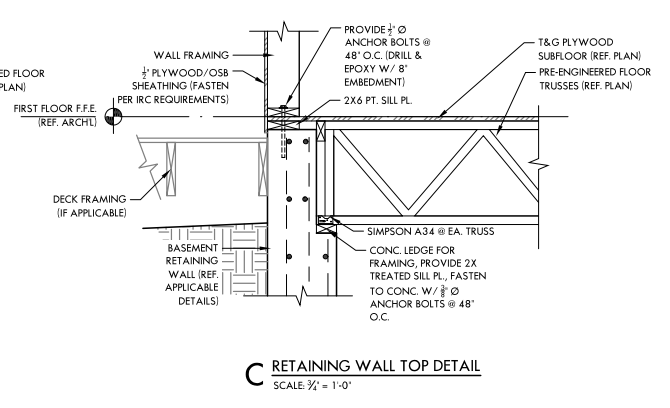1st Post. Wrestling with a residential construction open web truss connection detail. I am NOT an engineer but a designer (residential). Find myself here quite a bit so figured I'd join up. I'll end up needing a structural engineer for this job but trying to get my head wrapped around a decent solution that I can present him with.
House I'm designing has a basement and I'm trying to keep finish floor at 1st floor ground level as low as possible. Since code requires clearances to wood framing members to be x distance this requires that I drop my open web wood floor trusses so that top chord is as close to the top of the cast-in-place basement wall as possible.... ideally at the same elevation as the PT Sill plate anchor bolted to the top of the basement wall in a typical bottom chord bearing condition.
Some ways that I can come up with to do this would be
1. Cast in a 4" deep shelf (Would give 3-1/2" bearing & 1/2" space required) at the top of the 10" CIP concrete wall either the full depth of the truss or something less (say double top chord depth) and just have the rest of the truss dropped below the shelf whatever distance required.
2. Anchor bolt a ledger board to the wall and attach trusses to that with hangers.
3. Attach truss hangers directly to the CIP concrete wall
4. Hang truss hangers from on top of the plate
5. Hang truss hangers from top of CIP concrete wall
With all the hangers, concerned about rust/ condensation
With the wood ledger concerned about moisture migration even with a vapor barrier between it and the CIP concrete
With not having the truss actually under the stud wall (in any of these conditions), concerned about how the detail works where the sub flooring "spans" the gap from the top of the truss to the top of the sill plate.... and getting this all lined up.
Anything I'm overlooking that can cause me/ my client problems with this down the road or during construction?
Looking to design in as much flexibility as possible but don't want to add unnecessary expense.
Any ideas/opinions as to the best way to approach this?
House I'm designing has a basement and I'm trying to keep finish floor at 1st floor ground level as low as possible. Since code requires clearances to wood framing members to be x distance this requires that I drop my open web wood floor trusses so that top chord is as close to the top of the cast-in-place basement wall as possible.... ideally at the same elevation as the PT Sill plate anchor bolted to the top of the basement wall in a typical bottom chord bearing condition.
Some ways that I can come up with to do this would be
1. Cast in a 4" deep shelf (Would give 3-1/2" bearing & 1/2" space required) at the top of the 10" CIP concrete wall either the full depth of the truss or something less (say double top chord depth) and just have the rest of the truss dropped below the shelf whatever distance required.
2. Anchor bolt a ledger board to the wall and attach trusses to that with hangers.
3. Attach truss hangers directly to the CIP concrete wall
4. Hang truss hangers from on top of the plate
5. Hang truss hangers from top of CIP concrete wall
With all the hangers, concerned about rust/ condensation
With the wood ledger concerned about moisture migration even with a vapor barrier between it and the CIP concrete
With not having the truss actually under the stud wall (in any of these conditions), concerned about how the detail works where the sub flooring "spans" the gap from the top of the truss to the top of the sill plate.... and getting this all lined up.
Anything I'm overlooking that can cause me/ my client problems with this down the road or during construction?
Looking to design in as much flexibility as possible but don't want to add unnecessary expense.
Any ideas/opinions as to the best way to approach this?

